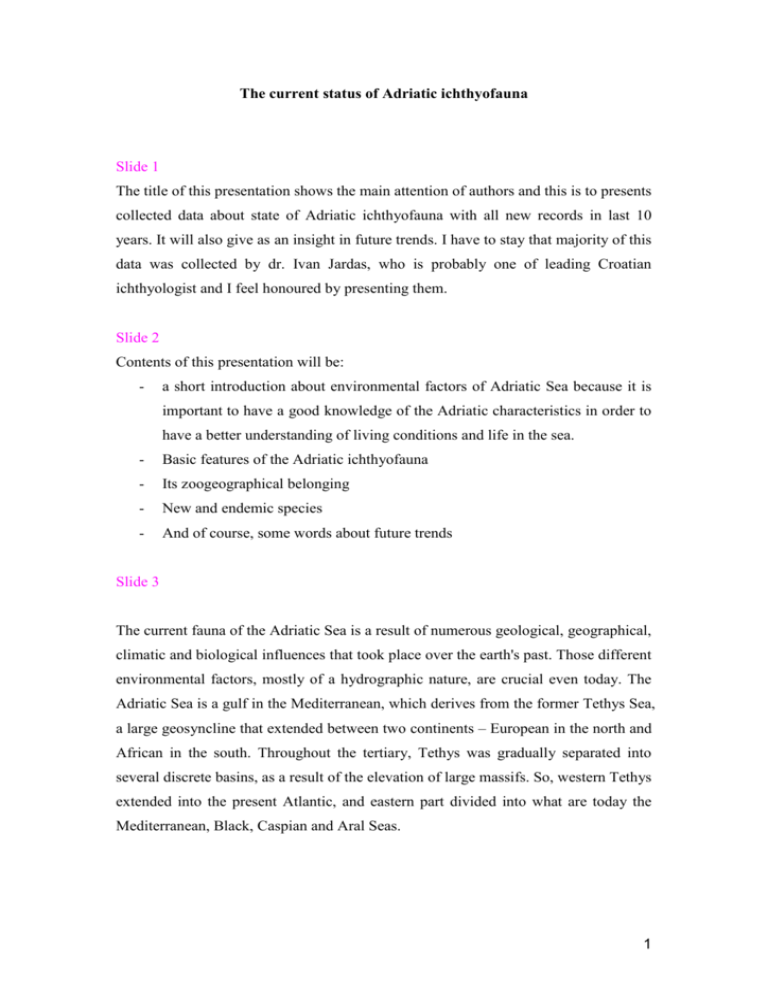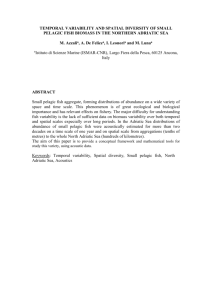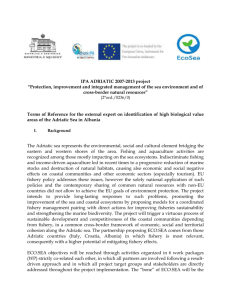The current status of Adriatic ichthyofauna
advertisement

The current status of Adriatic ichthyofauna Slide 1 The title of this presentation shows the main attention of authors and this is to presents collected data about state of Adriatic ichthyofauna with all new records in last 10 years. It will also give as an insight in future trends. I have to stay that majority of this data was collected by dr. Ivan Jardas, who is probably one of leading Croatian ichthyologist and I feel honoured by presenting them. Slide 2 Contents of this presentation will be: - a short introduction about environmental factors of Adriatic Sea because it is important to have a good knowledge of the Adriatic characteristics in order to have a better understanding of living conditions and life in the sea. - Basic features of the Adriatic ichthyofauna - Its zoogeographical belonging - New and endemic species - And of course, some words about future trends Slide 3 The current fauna of the Adriatic Sea is a result of numerous geological, geographical, climatic and biological influences that took place over the earth's past. Those different environmental factors, mostly of a hydrographic nature, are crucial even today. The Adriatic Sea is a gulf in the Mediterranean, which derives from the former Tethys Sea, a large geosyncline that extended between two continents – European in the north and African in the south. Throughout the tertiary, Tethys was gradually separated into several discrete basins, as a result of the elevation of large massifs. So, western Tethys extended into the present Atlantic, and eastern part divided into what are today the Mediterranean, Black, Caspian and Aral Seas. 1 Slide 4 The Adriatic is usually for practical purposes divided into northern, central and southern parts. According to this division, northern Adriatic stretches to an imagined diagonal line from Karlobag to Ancona, central part stretches from this line to line between Split and M. Gargano, while south Adriatic comprises the area to the south of this line. The north Adriatic is the northernmost part of the Mediterranean and by physical features partially influences the eastern Mediterranean and by biological features has boreal properties. Central Adriatic is characterised by Jabuka pit, and south Adriatic as deepest part with the depth of 1330 m. The Adriatic, which covers about 4,6 % of the entire Mediterranean, is linked with its other parts by the Strait of Otranto. Slide 5 Depth: The Adriatic Sea is shallow sea in which continental shelf covers about 74% of its surface. The depth of the Adriatic gradually increases from the northwest to the southeast. An isobath of 100 m is located on the line passing through Kornati Archipelago. Depths greater than 200 m are found around Jabuka Pit (273 m) and in the South-Adriatic Pit (1330m). The mean depth is 251 m. Considering the configuration of the sea floor, the bathymetric characteristics and the general scheme of a bathymetric division of the zones in the Adriatic Sea, the pelagic zone includes an epipelagic, a mesopelagic and perhaps a bathypelagic zone. In the benthal zone there is an intertidal zone, a continental shelf and a continental slope or bathyal zone. Slide 6 Salinity: The Adriatic basin is distinguished by relatively high salinity of about 38.3 psu, which is somewhat, less than in the eastern Mediterranean (39 psu) and more than the salinity in the western Mediterranean (37psu). Generally, salinity falls from the south towards the north, and from open sea towards the coast. This can be explained by the influx of more salty eastern Mediterranean water into the Adriatic on the one hand, and by the influence of continental waters on the other. Besides the normal annual fluctuation of salinity, in some years there is a more powerful influx of the more salty eastern Mediterranean water into the Adriatic Sea, called Adriatic ingression. The phenomenon is related to shifting of water masses 2 between eastern Mediterranean and Adriatic Sea due specific distribution of low pressure in eastern Mediterranean, and probably play important role regarding the presence of some rare and new species in Adriatic. Temperature: Temperature in Adriatic indicates that it is a warm sea. The water in its deepest layers is almost always above 12°C. In the open sea summer surface temperature is usually between 22-25°C falling to around 12°C in deepest parts. During winter, south Adriatic is wormer than central and north, and open sea is wormer than coastal waters. But difference in temperature between CA and SA is not significant. During summer months, thermocline is formed at a depth of about 10-30m. But, in autumn, and particularly during winter, because of the cooling and mixing of water layers caused by bora wind blowing, isotherms is created, firstly it is about 1819°C, and than fall to 11-12°C. Movement of water masses: The movement of the water masses in the Adriatic Sea depends primarily on its geomorphological, meteorological (heating, winds) and hydrographic characteristics. Except geomorphological, all factors have a seasonal or local significance for the dynamics of the water masses. Generally, Adriatic Sea can be divided in three distinct horizontal layers: the surface, intermediary and bottom layers, all with more or less independent systems of circulation, influencing one another to a certain extent. The flow in surface layer is basically cyclonic, the water flow in from the eastern Mediterranean along the eastern coast, and flow out along the western coast. This flow has strong seasonal characteristics, with grater influx in winter and grater outflow in summer. This rhythm is also additionally influenced, mostly in positive way, by winds. In the intermediary layer, inflow predominates throughout the year, especially in summer, due compensation for surface outflow. The current in bottom layer is least known. Otflow predominates, particularly in winter, when it appears as a compensatory current to the inflow in surface and intermediary layers. In winter this water is created in norh Adriatic by blending of cold and heavy water. Slide 7 The current checklist includes a total of 437 Adriatic fish species and subspecies (Myxini 1, Cephalaspidimorphi 3, Chondrichthyes 55, Actinopterygii 379), which make about 65% of Mediterranean species and subspecies (about 672). The quoted 3 number of fish species has been grouped into 2 classes, 22 orders and 124 families. Of total number of families, 21 belong to Chondrichthyes. However, the list comprises about 20 species whose findings are old, questionable and/or imprecise, so their presence needs to be confirmed. Also, the greatest part of the south Adriatic basin, particularly depths under 500m has not been sufficiently explored. The third reason for the uncertainty about the exact number of Adriatic fish is some unsolved taxonomic questions of some fish species especially of gobids. Slide 8 According to biogeographical determination, the highest number of Adriatic fish belongs to Atlanto-mediterranean species (> 65%) and Mediterranean species (20%). Others are cosmopolites and species of wider geographical distribution (11% - tunas, some meso and bathypelagic species). There are also 9 lessepsian migrants and 6 endemic species. If mediterranean-atlantic biogeographic elements are considered, the greatest number of the Adriatic representatives belongs to the eastern Atlantic boreal zone (40%). This boreal elements gives a special character and place of Adriatic Sea in Mediterranean (genus Raja Mustelus, Pleuronectes, Scophthalmus, gadides, Sprattus, Belone, Dicentrachus, ,…). Around 18% of the Adriatic ichthyofauna is belonging to Mediterranean species. There are not endemic mediterranean species, but those in a wider sensethat can be found also in neighbouring section of eastern Atlantic, in the region of Gibraltar, between Portugal and Mauritania, and sometimes including the Azores, Medeira and the Canary islands. Also, there are 3% of species that are distributed only in Mediterranean and Black Sea. Generally speaking, the greatest differences are found between ichthyofauna of the Black Sea and the rest of Mediterranean. Also, greater similarities exists between Adriatic and western Mediterranean (by number of typical fish species) although the Adriatic is both geographically and physiograpically a part of the eastern Mediterranean. But those differences become less prominent due global changes. Slide 9 4 This slide presents 32 new species recorded in last decade and those in yellow are Lessepsian migrants, the species that originate from Indo-Pacific region, and entered in Mediterranean from Red Sea through Suez channel. The entering was impossible until to the moment when salinity becomes similar to those of the eastern Mediterranean, but after that more than 30 species entered in it. Besides salinity, high turbidity and length of channel are main obstructions for the fishes on that way. Slide 10 Adriatic endemic species is also rare. There are only some species and subspecies (among the Atlantic-Mediterranean species) of the families of Gobiidae, Syngnathidae and Acipenseridae. In mediterranean ichthyofauna, also, is the highest number of endemic species from the family of Gobiidae. Moreover, all Adriatic endemic species are found in shallow zone, from 0-50 m of depth. But all this records are under question, because every day we have informations, which are still not confirmed, about records of this endemic species in other regions out of Adriatic Sea. Slide 11 The highest number of fish species is recorded in whole Adriatic (56.5%), following by those distributed in middle and southern part (16.7%) or just in southern part (15.8%), respectively. Moreover, number of fish species falls from southern to northern Adriatic. Every of Adriatic division (north, central, south) have few typical elements of the ichthyofauna, which distinguish them from one another. Thus, northern Adriatic is characterised by boreal features and boreal elements of the ichthyofauna more than other parts (Sprattus, Solea,..). Central and South Adriatic due certain environmental similaritirs (depth, water temperature) have more similar ichthyofauna with more thermophile elements (Thalassoma, Sparisoma, Brama,…).Central Adriatic especially marked, as was shown earlier, by the Jabuka pit, where some boreal and termophile elements of the ichthyofauna are complemented by some batyphile elements; finally, the deep south adriatic with a distinct bathyphile ichthyofauna and numerous thermophile elements, many of which occur in this region only. Slide 12 5 The most dominant families are Gobiidae (46), Labridae (18), Sparidae (18), Blennidae (17) and Myctophidae (15). According to the number of fish species, the Adriatic Sea is one of the richer seas, although, by the density of populations and capacity for exploitation it can be compared with poorer seas. According to ecological affiliation and horizontal distribution, southern Adriatic is characterized by higher presence of termophilic and batiphilic species while more boreal species are recorded in northern Adriatic. Slide 13 According to the annual catch of fish and other sea organisms in Adriatic Sea, it comprise about 15% of the total catch in Mediterranean, and takes second or third place between 10 fishing regions in this area (togerther with Italian catch). From 1983, a constant drop in quantity of fish caught can be followed. The largest biomass in the Adriatic is made up of small pelagic fish (> 50% of total catch), so that these few species comprise the greatest share in the eastern Adriatic commercial catch. Another hundred or so other species have some economic significance, and are therefore more important than just being members of the Adriatic ichthyofauna. During last 20 years demersal fishing takes more significant place due greater profitability and higher market prices of so called white fishes. Special attention has to be directed to coastal fisheries because more than 50 fishing gears are used in Croatian coastal fisheries of which many are unique, like tramata fishing. Coastal waters are one of rather important fishing grounds of the eastern Adriatic Sea. The area is the most productive Adriatic zone owing to the vicinity of the land and fresh water inflows. The statistics on marine fishing published by the Institution of Statistics of the Republic of Croatia shows that in recent years (1983-1999) landings ranged from 2400-5400 mt in the eastern Adriatic. The coastal part in that total catch provides 12-13%, but one great part of demersal and small pelagic fishing is also realized from the coastal area. Changes in the communities of fish and edible invertebrates, manifested as changes in quantitative and qualitative catch structure, are due to various reasons, particularly to that intensive fishing. The long-term monitorings of coastal communities could provide information on the trend and intensity of those changes. 6 Slide 14 Adriatic Sea is one of the most productive and most exploited regions in Mediterranean. Although by its surface area the Adriatic is small sea (5,5 % % of M), it yields about 15% of total catch in Mediterranean. Taking into account only large vessels, there are about 8000 trawlers, puirse seiners etc. We can therefore say that, on the whole, the Adriatic is an overfished sea. This is particularly the case with the trawling grounds of the open Central Adriatic (Blitvenica, Jabuka Pit), as well as the channels, western Italian sector, eastern coastal region, and of the fish species hake and red mullet in particular. Although, the strong low regulatives are brought, still the application of this regulatives has to be improved. Also, indirect damages of fishing, particularly of trawling, is very evident. Slide 15. Apart from unreasonable and uncontrolled fishing, a certain harmful influence on the coastal biological resources is the constant growing pollution of the sea, particularly in urban and industrial centres. The actual influence of pollution on ichthyofauna is hard to be estimated. While adult fishes will probably escape from polluted area, fish in early developmental stages is very vulnerable. A special problem is eutrofication, process by which the sea is enriched with nutrients stimulating primary production. The special problem is river Po, which contributes more than 50% of total inflow of nutrients in Adriatic. In open sea, eutrofication is not a problem up to a certain level, but in semi-open regions represents a threat to marine life. It can be manifested by anoxia that can cause mortality of numerous marine organisms. Slide 16. A large number of fish is protected in various ways by legal measures for fish and other marine organism conservation by Sea Fishery Act of the Republic of Croatia. The regulation includes 60 fish species inhabiting the pelagic waters, trawling grounds or coastal area. On that way, we try to protect population not reproductively mature. Other measures are: close season, close areas, temporary fishing prohibition, and control of harmful fishing gear, meshsize. Also, in Croatia there are several areas, which are declared as special habitats, parks, or marine protected areas as Kornati, Mljet. And, at the end red book of Adriatic Sea is preparing and will be reported very soon. 7 8






